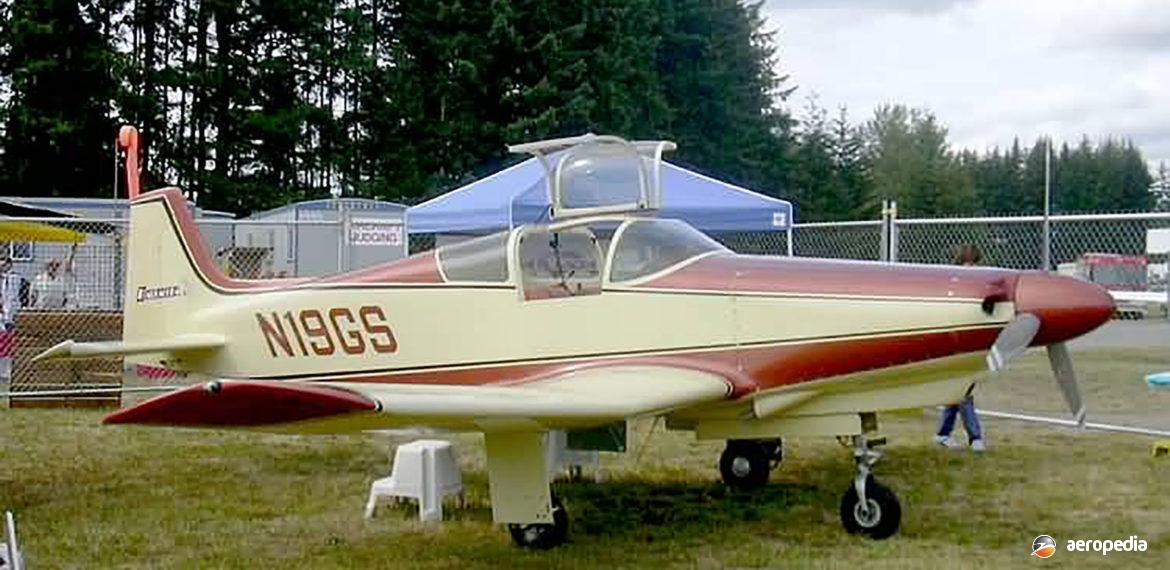Photograph:
Jeffair Barracuda N19GS (c/n 001) at Arlington, Washington, USA (Author’s collection)
Country of origin:
United States of America
Description:
Two-seat sport monoplane
Power Plant:
One 186 kw (250 hp) Avco-Lycoming IO-540-C4B5 six-cylinder horizontally-opposed air-cooled engine
Specifications:
- Wingspan: 7.54 m (24 ft 9 in)
- Length: 6.5 m (21 ft 6 in)
- Wing area: 11.15 m² (120 sq ft)
- Max speed at 2,135 m (7,000 ft): 355 km/h (208 mph)
- Cruising speed at 62% power at 2,450 m (8,050 ft): 300 km/h (187 mph)
- Stalling speed clean: 103 km/h (64 mph)
- Stalling speed wheels and flaps down: 100 km/h (62 mph)
- Max rate of climb at sea level: 762 m/min (2,500 ft/min)
- Range at max take-off weight, 65% power with auxiliary tank, and 30 mins reserve: 1,480 km (920 miles)
- Empty weight: 712 kg (1,570 lb)
- Loaded weight: 1,043 kg (2,300 lb)
History:
The Jeffair Barracuda was designed by Geoffrey Siers, a former Royal Air Force (RAF) pilot and design engineer with British Aerospace, who moved to the United States in 1964. The prototype N19GS (c/n 001) was first flown on 29 June 1975 and, powered by a 164 kw (220 hp) Avco-Lycoming GO-435-2 engine, won the “Most Outstanding New Design Award” at the 1976 Oshkosh Experimental Aircraft Association (EAA) Fly-in in Wisconsin. In 1979 the engine was replaced by the more powerful Lycoming O-540 series. Subsequently, over 500 sets of plans were sold throughout the world, and at least 30 have been completed.
Wings were cantilever low-wing monoplane, built in three pieces with a basic structure of spruce, with mahogany and birch plywood covering. The main spar was of box section with spruce booms and ply web. Electrically-operated flaps were fitted on the entire centre- section trailing-edge extending under the fuselage. The fuselage was of conventional spruce structure covered with birch plywood stressed skin. The undercarriage was of the retractable tricycle type with electro-hydraulic operation. Accommodation was provided for two persons with dual controls, and the aircraft had a baggage area behind the seats. Engines ranging in power from 112 kw (150 hp) to 224 kw (300 hp) could be fitted, and total fuel capacity was normally 166 litres (36.5 Imp gals) although provision was made for two 23 litre (5 Imp gal) auxiliary tanks in the outboard wing panels.
Two examples have been seen in this region. The first aircraft was built in Australia and had the registration VH-MSZ (c/ n 539) reserved. However, the owner moved to New Guinea where the Barracuda was painted as P2-JEF, although it was not officially registered. At some time it is believed to have suffered some damage and was last noted at Port Moresby in May 1993.
Construction of a further example was commenced in August 2003 in Queensland, this being known as a Siers Barracuda. Plans for this variant became available from Siers Flight Systems, this aircraft having the registration VH-LDG³ (c/n Q122) allotted and was expected to be based at Rockhampton, QLD when completed. Plans are also known to have become available from Buethe Enterprises Inc of Cathedral City, California, United States of America.

